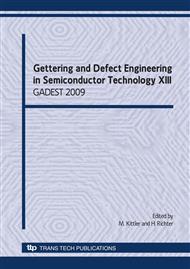p.115
p.123
p.129
p.135
p.139
p.145
p.149
p.155
p.161
Vacancies and Self-Interstitials Dynamics in Silicon Wafers
Abstract:
Successful theoretical models of vacancies, self-interstitials and oxygen dynamics during an ingot growth lead us to apply these models results also to silicon wafers. The modern silicon technology uses successfully the RTA (rapid thermal annealing) in order to form MDZ (magic denude zone) in individual CZ Si wafers. The effect of RTA is based on the utilization of vacancies for control of oxygen precipitation. The question about the theory of kinetics of vacancies and interstitials, which describes its behavior within RTA, is still opened up to now. This work deals mainly with the nucleation of vacancies during RTA concerning various cooling rates and initial states.
Info:
Periodical:
Pages:
139-144
Citation:
Online since:
October 2009
Keywords:
Price:
Сopyright:
© 2010 Trans Tech Publications Ltd. All Rights Reserved
Share:
Citation:


